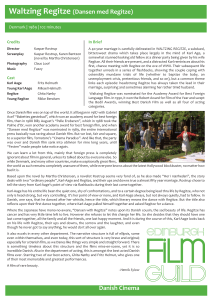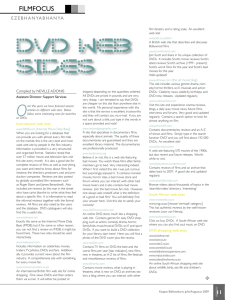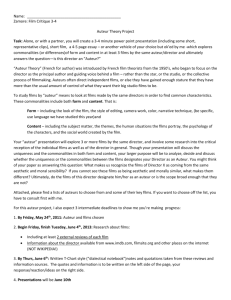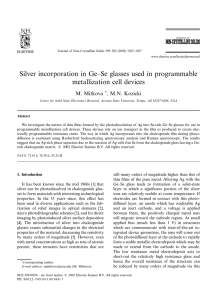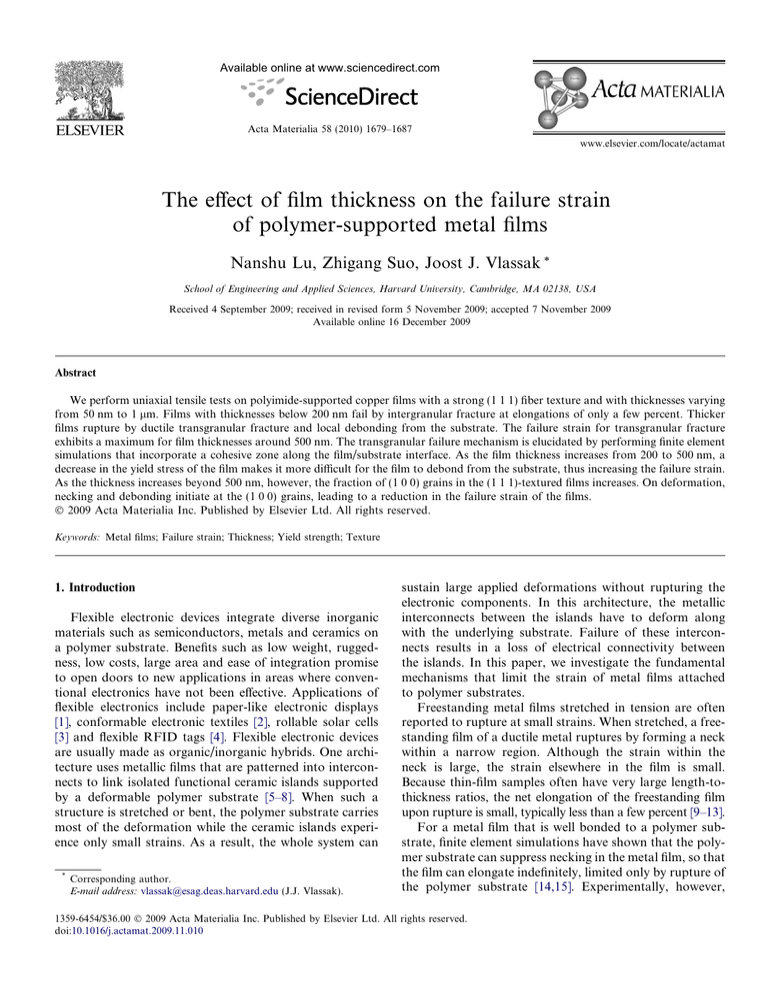
Available online at www.sciencedirect.com
Acta Materialia 58 (2010) 1679–1687
www.elsevier.com/locate/actamat
The effect of film thickness on the failure strain
of polymer-supported metal films
Nanshu Lu, Zhigang Suo, Joost J. Vlassak *
School of Engineering and Applied Sciences, Harvard University, Cambridge, MA 02138, USA
Received 4 September 2009; received in revised form 5 November 2009; accepted 7 November 2009
Available online 16 December 2009
Abstract
We perform uniaxial tensile tests on polyimide-supported copper films with a strong (1 1 1) fiber texture and with thicknesses varying
from 50 nm to 1 lm. Films with thicknesses below 200 nm fail by intergranular fracture at elongations of only a few percent. Thicker
films rupture by ductile transgranular fracture and local debonding from the substrate. The failure strain for transgranular fracture
exhibits a maximum for film thicknesses around 500 nm. The transgranular failure mechanism is elucidated by performing finite element
simulations that incorporate a cohesive zone along the film/substrate interface. As the film thickness increases from 200 to 500 nm, a
decrease in the yield stress of the film makes it more difficult for the film to debond from the substrate, thus increasing the failure strain.
As the thickness increases beyond 500 nm, however, the fraction of (1 0 0) grains in the (1 1 1)-textured films increases. On deformation,
necking and debonding initiate at the (1 0 0) grains, leading to a reduction in the failure strain of the films.
Ó 2009 Acta Materialia Inc. Published by Elsevier Ltd. All rights reserved.
Keywords: Metal films; Failure strain; Thickness; Yield strength; Texture
1. Introduction
Flexible electronic devices integrate diverse inorganic
materials such as semiconductors, metals and ceramics on
a polymer substrate. Benefits such as low weight, ruggedness, low costs, large area and ease of integration promise
to open doors to new applications in areas where conventional electronics have not been effective. Applications of
flexible electronics include paper-like electronic displays
[1], conformable electronic textiles [2], rollable solar cells
[3] and flexible RFID tags [4]. Flexible electronic devices
are usually made as organic/inorganic hybrids. One architecture uses metallic films that are patterned into interconnects to link isolated functional ceramic islands supported
by a deformable polymer substrate [5–8]. When such a
structure is stretched or bent, the polymer substrate carries
most of the deformation while the ceramic islands experience only small strains. As a result, the whole system can
*
Corresponding author.
E-mail address: vlassak@esag.deas.harvard.edu (J.J. Vlassak).
sustain large applied deformations without rupturing the
electronic components. In this architecture, the metallic
interconnects between the islands have to deform along
with the underlying substrate. Failure of these interconnects results in a loss of electrical connectivity between
the islands. In this paper, we investigate the fundamental
mechanisms that limit the strain of metal films attached
to polymer substrates.
Freestanding metal films stretched in tension are often
reported to rupture at small strains. When stretched, a freestanding film of a ductile metal ruptures by forming a neck
within a narrow region. Although the strain within the
neck is large, the strain elsewhere in the film is small.
Because thin-film samples often have very large length-tothickness ratios, the net elongation of the freestanding film
upon rupture is small, typically less than a few percent [9–13].
For a metal film that is well bonded to a polymer substrate, finite element simulations have shown that the polymer substrate can suppress necking in the metal film, so that
the film can elongate indefinitely, limited only by rupture of
the polymer substrate [14,15]. Experimentally, however,
1359-6454/$36.00 Ó 2009 Acta Materialia Inc. Published by Elsevier Ltd. All rights reserved.
doi:10.1016/j.actamat.2009.11.010
1680
N. Lu et al. / Acta Materialia 58 (2010) 1679–1687
most polymer-supported thin metal films rupture at small
elongations (<10%) [16–23], even though elongations as
high as 20% have been reported in a few cases [24–26].
Our recent experiments have achieved elongations over
50% of polyimide-bonded Cu films without detectable fracture [27]. We have demonstrated that good adhesion
between film and substrate is critical to achieving large failure strains, an observation that is consistent with both theoretical predictions [15] and a previous experimental
investigation [22].
Strong adhesion is not the only condition required to
achieve large failure strains. It is also important to ensure that
deformation occurs as uniformly as possible. Another set of
experiments showed that sputtered Cu films rupture at much
smaller strains in their as-deposited state as compared to
annealed films [28]. Without thermal treatment, the microstructure of as-deposited Cu films is unstable during deformation and room-temperature grain growth is observed under
mechanical loading. Eventually, the films fail by ductile necking as a result of concurrent grain growth, strain localization
at large grains and film debonding from the substrate.
In this paper, we present a comprehensive experimental
study of the effect of film thickness on the failure strain of
annealed Cu coatings supported by polyimide substrates.
The yield strength and crystallographic texture of the film
are found to have a significant impact on the failure strain.
These effects are further elucidated by modelling ductile
fracture of the coatings using the finite element method.
The paper is organized as follows. Section 2 describes the
experimental setup and procedures. Experimental results
including resistance–elongation measurements and sample
micrographs are provided in Section 3. The finite element
simulations are described in Section 4. Final conclusions
are given in Section 5.
2. Experimental detail
The polymer substrates used in this study were 12.7 lm
Ò
polyimide foils (Kapton 50HN by DuPont, Circleville,
OH). Immediately prior to the deposition of metal films,
the substrates were ultrasonically cleaned with acetone
and methanol. The substrates were then covered by a shadow mask with seven 5 50 mm2 rectangular windows and
placed inside the chamber of a direct-current (DC) magnetron sputter-deposition system with a base pressure better
than 1 107 Torr. After sputter cleaning for 5 min with
an Ar plasma at a radio-frequency power of 24 W and a
pressure of 2 102 Torr, a Cu layer was deposited onto
the substrates through the windows in the shadow mask.
The deposition was performed using a 50.8 mm Cu target
at a DC power of 200 W and a working gas (Ar) pressure
of 5 103 Torr. The nominal target–substrate distance
was 100 mm and the corresponding deposition rate was
0.39 nm s–1. The thickness of the film was controlled by
varying the deposition time. These deposition conditions
are similar to those used in Refs. [27,28]. Immediately after
deposition, the Cu films were annealed at 150 °C for 1 h.
Annealed specimens were removed from the vacuum chamber after 12 h to allow them to cool down prior to breaking
vacuum. Additional annealing under these conditions did
not further increase the grain size.
The microstructure of the films was characterized by
means of focused ion beam (FIB) imaging in a Zeiss NVision40 Dual-Beam FIB/SEM (Carl Zeiss Inc. Thornwood,
NY). Fig. 1a shows typical FIB images for the 50 nm and
1 lm films, illustrating the change in grain size with film
thickness. The crystallographic texture of the films was
measured using electron backscattered diffraction (EBSD).
The EBSD measurements were performed in a Zeiss
Supra55VP SEM. Fig. 1b shows orientation maps for the
500 nm and 1 lm films respectively. Grains marked blue
are oriented with the (1 1 1) plane parallel to the surface,
grains in red1 are (1 0 0) oriented and grains labelled green
possess a (1 0 1) orientation. Both films show a strong
(1 1 1) texture, but the 1 lm film contains more (1 0 0)
grains than the 500 nm film, as also observed in similar
polyimide-supported Cu films [29]. The volume fractions
of (1 0 0) grains were estimated from at least five EBSD
images for each film thickness and are listed in Table 1.
The average grain size was determined by the intercept
method with twins counted as separate grains, the same
method as used in Ref. [30]. The relation between film
thickness and grain size is shown in Fig. 1c. The volume
fraction of (1 0 0) grains and grain size are tabulated in
Table 1 for further reference.
Rectangular tensile test specimens with a width of 5 mm
were cut from the metal-coated substrates using a razor
blade. The specimen gauge length was L0 = 30 mm. The
specimens were then subject to uniaxial tension using an
Instron 3342 tensile tester. All tests were performed at room
temperature at a constant strain rate of 3.3 104 s1.
During tensile testing, the electrical resistance of the films
was measured in situ using a Keithley 2000 multimeter in
a four-point measurement setup. We used the Zeiss NVision40 Dual-Beam FIB/SEM to examine specimens
stretched to different elongations after unloading. At least
six samples were tested for each thickness.
3. Results
3.1. In situ resistance measurements and failure strain
determination
Fig. 2a shows typical experimental resistance–elongation curves for films with thicknesses ranging from 50 nm
to 1 lm, along with the theoretical curve
R=R0 ¼ ðL=L0 Þ
2
ð1Þ
which holds as long as there are no resistivity or volume
changes during the experiment. We define the failure strain,
1
For interpretation of color in Figs. 1, 2 and 4–8, the reader is referred
to the web version of this article.
N. Lu et al. / Acta Materialia 58 (2010) 1679–1687
1681
Fig. 1. (a) Focused ion beam images of films with various thicknesses. (b) Crystal orientation maps for the 500 nm and 1 lm films. (c) Grain size (squares)
and yield strength (dots) as a function of film thickness. Yield strengths are calculated from the Hall–Petch relation ry = r0 + kd1/2 using the coefficients
r0 ¼ 42 MPa and k = 6008.3 MPa nm1/2 from Ref. [30].
Table 1
Microstructure and strain-to-rupture of films.
Thickness, h (nm)
f(100) (%)a
Grain size, d (mm)a
Yield strength, ry (MPa)
Strain-to-failure (experimental) (%)b
Strain-to-failure (FEM) (%)
50
100
200
350
500
1000
4.3 ± 0.4
4.1 ± 1
4.1 ± 0.5
4 ± 0.2
4.3 ± 0.5
7.4 ± 0.2
98.6 ± 8
162.7 ± 15
231.3 ± 20
315.8 ± 22
397.2 ± 28
687.4 ± 33
647
513
437
380
343
271
4.5 ± 1
8.3 ± 2.2
17.8 ± 0.1
24.4 ± 1.5
54.2 ± 0.5
39.8 ± 0.5
11
19
32
45.6
54
10.6
a
b
Errors denote the standard deviation for five different EBSD micrographs.
Errors denote the standard deviation for at least three different samples of a given thickness.
er, as the strain at which the experimental curve deviates
from the theoretical curve by 0.05. We have verified that
for our films this strain indeed corresponds to the strain
at which cracks start to initiate on a large scale [27,28].
With this definition, we can plot the failure strain as a function of film thickness in Fig. 2b. It is evident from Fig. 2a
and b that the 500 nm films have the highest failure strain,
approximately 54%, among the six sets of samples that
were tested. The 1 lm films fail at slightly smaller strains.
As the film thickness decreases below 500 nm, the failure
strain decreases rapidly; the 50 nm films rupture at strains
not greater than 5%. Representative SEM micrographs of
films after a 30% elongation are shown in Fig. 2c. No
cracks can be found in the 1 lm or 500 nm films and their
resistances do not deviate from Eq. (2), as shown in Fig. 2a.
By contrast, isolated microcracks can be found in the 350
1682
N. Lu et al. / Acta Materialia 58 (2010) 1679–1687
Fig. 2. (a) Experimental resistance as a function of uniaxial film elongation, along with the theoretical resistance assuming volume conservation and no
resistivity change during deformation; (b) failure strain as a function of film thickness; (c) micrographs of films stretched by 30%. Loading is along
horizontal direction for all micrographs.
N. Lu et al. / Acta Materialia 58 (2010) 1679–1687
and 200 nm films and moderate offsets of their resistances
from Eq. (2) are observed in Fig. 2a. As the film thickness
decreases below 200 nm, the crack density increases markedly and the cracks are interconnected, explaining the steep
rise in film resistance observed in Fig. 2a. In the following,
we will elucidate the mechanisms that are responsible for
the observed variation in the failure strains.
3.2. Transgranular vs. intergranular fracture
Films with thicknesses of 200 nm or greater can accommodate large strains without forming cracks. Fig. 3 shows
plan-view and cross-sectional FIB micrographs of 1 lm,
500 nm and 200 nm films deformed to elongations of
70%, 70% and 40%, respectively. Abundant slip traces of
dislocations can be observed in Fig. 3a, c and e, indicating
that all three films have experienced extensive plastic deformation. When 1 lm and 500 nm films are stretched 70%,
Fig. 3a and c and many other micrographs like them show
that only isolated transgranular cracks associated with one
or two grains can be detected. The cross-sectional images
(Fig. 3b and d) reveal that the films rupture by a ductile
mechanism, in which debonding and necking coevolve.
This observation is consistent with previous computational
[14,15] and experimental [27] studies. The 200 nm films
show more extensive cracking at 40% strain (Fig. 3e), but
failure still occurs through ductile transgranular fracture.
A cross-sectional view (Fig. 3f) at the site of one of the
microcracks shows that the film ruptures by debonding
from the substrate and by necking down to a knife-edge.
The micrographs in Fig. 3 are representative of all films
with thicknesses between 1 lm and 200 nm. We conclude
that there is no change in failure mode as the film thickness
decreases from 1 lm to 200 nm.
By contrast, a different failure mode is found in films
with thicknesses equal to or smaller than 100 nm. Fig. 4
1683
shows top and cross-sectional images of 100 and 50 nm
films strained to 40% and 30%, respectively. As opposed
to the transgranular cracks observed in the submicron
films, Fig. 4a and c shows irregularly notched crack paths
that follow the grain boundaries, indicating intergranular
fracture. The intergranular cracks are often interconnected,
forming long transverse cracks that are particularly detrimental to the conductivity of the film. Metal films in this
thickness range have a large yield strength and are difficult
to deform plastically because of dimensional constraints on
dislocation activity [31]. The high level of stress supported
by these films evidently triggers grain boundary decohesion
before ductile failure occurs. Since grain boundary decohesion is a relatively brittle fracture mechanism compared to
necking, the total elongation at failure is small. Furthermore, no debonding is required to accommodate local displacements because grain boundary decohesion does not
involve large local elongations. Consequently, no necking
or debonding is observed in Fig. 4b and d.
3.3. Preferred transgranular fracture at (1 0 0) grains
As illustrated in Fig. 2b, the 1 lm films have a smaller failure strain than the 500 nm films. It is evident from Fig. 3a–d
that there is little difference between the morphologies of the
two films after 70% strain. In both cases, only isolated transgranular cracks associated with one or a few grains are
found. The reduced strain-to-failure of 1 lm films is
explained, however, by noting that the transgranular cracks
are associated predominantly with (1 0 0) oriented grains.
It is well known that the crystallographic texture of a film
varies with film thickness as a result of a trade-off between
interfacial energy and strain energy [32]. In particular, thin
films of face-centered cubic (fcc) metals tend to have a
strong (1 1 1) texture, while thicker films also have a
(1 0 0) texture component that increases with film thickness
Fig. 3. Surface and cross-sectional views of 1 lm, 500 nm and 200 nm films stretched by 70%, 70% and 40%, respectively. These images are representative
of all films with thicknesses between 200 nm and 1 lm. Loading is along horizontal direction for all micrographs.
1684
N. Lu et al. / Acta Materialia 58 (2010) 1679–1687
Fig. 4. Surface and cross-sectional views of 100 and 50 nm films stretched
by 40% and 30%, respectively. Loading is along the horizontal direction
for all micrographs.
[29,33–38]. Orientation maps of 500 nm and 1 lm films
obtained by EBSD are shown in Fig. 1b. Grains with a
(1 0 0) orientation have a much lower flow stress than
(1 1 1) grains. This is evident, for instance, if one calculates
the Taylor factor for an fcc film with a (1 1 1) and a (1 0 0)
fiber texture subjected to uniaxial deformation, yielding a
flow stress ratio, r(111)/r(100), as large as 2.41. Calculation
of the corresponding Schmidt factors also leads to the conclusion that the (1 0 0) grains have a lower flow stress than
(1 1 1) grains [38]. Consequently, (1 0 0) grains in a (1 1 1)
textured film can be regarded as soft inclusions embedded
in a hard matrix. Because the inclusion has a lower flow
stress and deforms more easily, it becomes a preferential site
for strain localization and necking. Large local elongation
triggers simultaneous debonding and ultimately evolves
into transgranular fracture. Once a microcrack forms, stress
concentrations at the crack tips may cause fracture in adjacent grains. Since the (1 0 0) grains are dispersed in the film,
only isolated transgranular cracks associated with one or
two grains are observed as illustrated in Fig. 3a and c. Given
that the 1 lm film contains a larger fraction of (1 0 0) grains
than the 500 nm film, this mechanism provides a simple
explanation why the strain-to-failure decreases with film
thickness above 500 nm.
To confirm that fracture indeed occurs predominantly at
(1 0 0) grains, we performed EBSD scans of regions containing microcracks in deformed 1 lm films. Fig. 5 shows
two of the many examples where transgranular cracks are
associated with at least one (1 0 0) grain. Due to extensive
plastic deformation and grain rotation, the EBSD indexing
rate is low and only partial grains can be identified. Even so,
a statistical study of the EBSD images of microcracks in six
samples deformed by 70% shows that the volume fraction of
(1 0 0) grains in images that contain a microcrack is at least
17%. This volume fraction is significantly larger than the
overall volume fraction of (1 0 0) grains, which is only 7%.
Fig. 5. Representative micrographs and corresponding crystal orientation
maps of regions with cracks in a 1 lm film deformed by 70%. The (1 0 0)
orientation is marked by red. (For interpretation of the references to color
in this figure legend, the reader is referred to the web version of this paper.)
4. Finite element simulations
To provide additional insight into the ductile failure
mode, we perform a finite element analysis of the film/substrate system. We use a finite element model similar to the
model described in Refs. [14,15]. Fig. 6a depicts a twodimensional plane-strain model of a blanket metal film
on a polymer substrate under uniaxial tension. The film
thickness h is varied over the range of the experimental values used in this study and the substrate thickness H is fixed
at 12.7 lm, the thickness of the Kapton 50HN substrate.
The length of the film in the model is set to L = 80 lm.
Both materials are modeled as homogeneous isotropic elastic–plastic solids with a uniaxial true stress–true strain relationship given by
8
< Ee; e 6 ry =E
N
ð2Þ
r¼
: ry e
; e > ry =E
ry =E
where E is Young’s modulus, ry is the yield stress and N is
the hardening exponent. The mechanical properties used in
the finite element calculations for Cu and Kapton are listed
in Table 2. The yield strength of the Cu films is estimated
from the grain size using the Hall–Petch relationship
ry ¼ r0 þ kd 1=2
ð3Þ
and is listed as a function of film thickness in Table 1. Values of r0 = 42 MPa and k = 6008 MPa nm1/2 have been obtained from bulge test measurements on unpassivated Cu
films with similar thicknesses deposited previously in the
same deposition system [30]. The yield strength is plotted
as a function of film thickness in Fig. 1c. The Kapton yield
strength and its Young’s modulus are measured directly in
uniaxial tensile tests on bare Kapton substrates; the other
N. Lu et al. / Acta Materialia 58 (2010) 1679–1687
1685
Fig. 6. (a) Two-dimensional plane-strain model of a polyimide-bonded copper thin film subjected to uniaxial stretching. A small notch is introduced as an
imperfection at the center of the film. Only the right half of the structure is modelled because of the symmetry. (b) Constitutive law of the cohesive zone at
the film/substrate interface.
parameters are typical values for this material. To model the
coevolution of necking and film/substrate debonding, a
cohesive zone that consists of an array of nonlinear springs
with the traction–separation relation shown in Fig. 6b is applied at the interface. The parameters rn and rs are the normal and the shear strengths; dn and ds refer to the normal
and the shear separations; the areas under the traction–separation curves are the respective toughnesses, denoted by Cn
and Cs. We assume the same interfacial parameters for all
simulations: rn = rs = 150 MPa, dn = ds = 1.5 nm and
Cn = Cs = 5 J m–2. These values are representative of a metal/polymer interface, and are chosen to fit the experimental
results.
Because of symmetry, only the right half of the system
needs to be modeled. The appropriate symmetry boundary
conditions are applied along the symmetry axis, and the
bottom point on this axis is fixed in space. The right side
of the model is subjected to a uniform horizontal displacement u. The engineering strain is given by eapp = 2u/L. A
small notch with a depth of 0.02h and a width of 0.2h is
introduced on the film surface at the center of the model
to serve as an imperfection where the neck can nucleate.
Both the film and the substrate are meshed by four-point
quadrilateral plane-strain elements. The cohesive layer consists of two-dimensional cohesive elements that share nodes
with film and substrate. As the simulation carries on,
coevolution of necking and debonding can be observed in
the vicinity of the notch. We define the failure strain as
the strain at which the local film thickness decreases to
one tenth of its original thickness. Since the FEM model
does not contain any grain boundaries, only films that fail
by ductile transgranular fracture are modeled. In the following, we first examine the effect of film thickness by
decoupling geometry and yield strength effects. Then we
examine the effect of crystallographic texture. A survey of
all simulation results is shown in Fig. 7.
4.1. Effect of geometry
To evaluate any geometric effects associated with changing the film thickness, we vary the film thickness in the
FEM simulations without changing the yield strength of
the films. The strains-to-failure are plotted as triangles in
Fig. 7; evidently the strain-to-failure is very nearly independent of film thickness. Fig. 8a–c shows the corresponding
deformed configurations; it is clear that there is no obvious
change in failure mode. This can be understood in terms of
the characteristic length scales of the film/substrate system.
First, the length scales associated with the traction–separation law for the cohesive zone, dn = ds = 1.5 nm, are at
least two orders of magnitude smaller than the film thicknesses considered in this study. Second, the substrate is at
least one order of magnitude thicker than the films. As a
result, relatively small changes in film thickness do not
affect the failure strain significantly.
Table 2
Material properties used in FEM simulations.
Material
Young’s Poisson’s Yield
modulus, ratio, v
strength, ry
(MPa)
E (GPa)
Kapton
2.34
Homogenized Cu 130
(1 0 0) Cu
93
(1 1 1) Cu
130
0.34
0.36
0.19
0.50
24
As labeled in Fig. 8
Hardening
exponent,
N
0.625
0.02
Fig. 7. Failure strain vs. film thickness obtained from FEM simulations.
1686
N. Lu et al. / Acta Materialia 58 (2010) 1679–1687
Fig. 8. Deformed configurations of metal films on polymer substrates obtained from FEM simulations. Only the right half of Fig. 6a is modeled. For
clarity, only part of the substrate is shown. (a–c) Films with fixed yield strength and varying thickness. (d) A film with reduced yield strength. (e) A 1 lm
film with a (1 0 0) grain.
4.2. Effect of yield strength
Fig. 1c shows that the yield strength of the Cu films
decreases with increasing thickness. To evaluate the effect
of the yield strength on the failure strain of the films, Cu
films are modeled with the yield strengths as listed in Table
1. The simulation results are plotted as dots in Fig. 7. The
failure strain now increases with increasing film thickness,
i.e. with decreasing yield strength. Evidently the yield
strength of the 1 lm film is so low that it does not fail. This
trend is readily understood. When the yield strength of the
film is large compared to the interfacial strength, the film
can exert large tractions on the interface, making it easier
to initiate debonding from the substrate. Once the film is
debonded, the substrate cannot suppress strain localization
anymore and the film fails by the coevolution of necking
and debonding. Increasing the yield strength of the films
clearly facilitates this process and decreases the failure
strain. If the film yield strength is too low, however, there
is insufficient driving force to initiate delamination and
the film can be stretched without ever debonding or necking. Fig. 8c and d illustrates this mechanism. For the same
film thickness and imposed strain, the film with the larger
yield strength has a much larger region of delamination.
Since debonding and necking facilitate each other, the
stronger film will rupture at a smaller elongation.
the 1 lm is not simulated correctly. We now investigate
the effect of texture on the failure strain by simulating a
soft (1 0 0) grain embedded in a 1 lm film with a (1 1 1)
fiber texture.
The size of the (1 0 0) inclusion is chosen such that the
volume fraction of (1 0 0) grains in the FEM model is same
as in the experiments. The elastic properties are calculated
from the Cu single-crystal constants, c11 ¼ 168:4 GPa,
c12 ¼ 121:4 GPa and c44 ¼ 75:4 GPa [39], by spatially averaging the properties in the (1 0 0) and (1 1 1) planes, yielding E(100) = 93 GPa, m(100) = 0.19, E(111) = 130 GPa and
m(111) = 0.50. The yield strengths are taken such that their
volume average is equal to the yield strengths listed in
Table 1 and their ratio is equal to the ratio of the in-plane
averaged Taylor factors, r(111)/r(100) = 2.41. The failure
strain is plotted in Fig. 7 with the label “(1 0 0) grains
included”. Compared to the homogeneous 1 lm film, this
film exhibits a much reduced failure strain. As illustrated
in Fig. 8e, this reduction is caused by an almost-immediate
strain localization in the soft inclusion. It should be noted
that the failure strain in the FEM model is much smaller
than that observed experimentally because of the twodimensional nature of the FEM model: the FEM model
assumes a strip of soft grains across the width of the film,
rather than dispersed (1 0 0) grains as observed in the
experiments (Fig. 1b).
4.3. Effect of film texture
5. Summary
The FEM model in the previous section assumes uniform properties for the Cu film; it does not capture any texture effects. Thus it is not surprising that the behavior of
We have carried out uniaxial tensile experiments on
polyimide-supported copper films with thicknesses varying
from 50 nm to 1 lm and a (1 1 1) fiber texture. The
N. Lu et al. / Acta Materialia 58 (2010) 1679–1687
experimental failure strains first rise with film thickness,
reach a maximum for film thicknesses around 500 nm
and then decrease again. Several factors are responsible
for this behavior. Films with thicknesses less than 200 nm
fail at very low strains as a result of intergranular fracture.
For thicker films, the failure mode switches to transgranular fracture in a process that involves both strain localization and debonding. As the yield strength decreases with
increasing film thickness, it becomes increasingly difficult
to debond the film from the substrate and the failure strain
increases. Eventually, a (1 0 0) texture component develops
in the films, leading to strain localization and fracture at
the softer (1 0 0) grains. This mechanism results in a lowering of the failure strain. Our observations suggest that the
failure strain of a metal film on a polymer substrate can be
maximized by ensuring good adhesion between film and
substrate, a uniform crystallographic texture, and a large
grain size to lower the yield strength.
Acknowledgements
The work presented in this paper was supported by the
National Science Foundation (NSF) under Grant CMS0556169, and by the Materials Research Science and Engineering Center (MRSEC) at Harvard University. It was
performed in part at the Center for Nanoscale Systems (CNS),
a member of the National Nanotechnology Infrastructure
Network (NNIN), which is supported by the National Science Foundation under NSF Award No. ECS-0335765.
CNS is part of the Faculty of Arts and Sciences at Harvard
University. The authors thank David Mooney for use of the
Instron tensile tester.
References
[1] Rogers JA, Bao Z, Baldwin K, Dodabalapur A, Crone B, Raju VR,
et al. Proc Natl Acad Sci USA 2001;98:4835.
[2] Bonderover E, Wagner S. IEEE Electron Device Lett 2004;25:295.
[3] Brabec CJ. Sol Energy Mater Sol Cells 2004;83:273.
[4] Miller P. SEL and TDK Announce World’s “First” Flexible RFID;
2006.
1687
[5] Ko HC, Stoykovich MP, Song JZ, Malyarchuk V, Choi WM, Yu CJ,
et al. Nature 2008;454:748.
[6] Bhattacharya R, Wagner S, Tung YJ, Esler JR, Hack M. Proc IEEE
2005;93:1273.
[7] Hsu PI, Bhattacharya R, Gleskova H, Huang M, Xi Z, Suo Z, et al.
Appl Phys Lett 2002;81:1723.
[8] Sun JY, Lu N, Yoon J, Oh KH, Suo Z, Vlassak JJ. J Mater Res
2009;24:3338.
[9] Keller RR, Phelps JM, Read DT. Mater Sci Eng, A 1996;214:42.
[10] Huang H, Spaepen F. Acta Mater 2000;48:3261.
[11] Xiang Y, Chen X, Vlassak JJ. Mater Res Symp Proc 2002;659:L4.9.
[12] Espinosa HD, Prorok BC, Fischer M. J Mech Phys Solids 2003;51:47.
[13] Lee HJ, Zhang P, Bravman JC. J Appl Phys 2003;93:1443.
[14] Li T, Huang ZY, Xi ZC, Lacour SP, Wagner S, Suo Z. Mech Mater
2005;37:261.
[15] Li T, Suo Z. Int J Solids Struct 2006;44:1696.
[16] Chui SL, Leu J, Ho PS. J Appl Phys 1994;76:5136.
[17] Kraft O, Hommel M, Arzt E. Mater Sci Eng 2000;A288:209.
[18] Hommel M, Kraft O. Acta Mater 2001;49:3935.
[19] Alaca BE, Saif MTA, Sehitoglu H. Acta Mater 2002;50:1197.
[20] Lacour SP, Wagner S, Huang Z, Suo Z. Appl Phys Lett 2003;82:2404.
[21] Yu DYW, Spaepen F. J Appl Phys 2003;95:2991.
[22] Xiang Y, Li T, Suo Z, Vlassak JJ. Appl Phys Lett 2005;87:161910.
[23] Niu RM, Liu G, Wang C, Zhang G, Ding XD, Sun J. Appl Phys Lett
2007:90.
[24] Kang YS. Microstructure and strengthening mechanisms in
aluminum thin films on polyimide film, Ph.D. Thesis, University
of Texas at Austin; 1996.
[25] Macionczyk F, Bruckner W. J Appl Phys 1999;86:4922.
[26] Gruber P, Böhm J, Wanner A, Sauter L, Spolenak R, Arzt E. Mater
Res Soc Symp Proc 2003;821:P2.7.
[27] Lu N, Wang X, Suo Z, Vlassak JJ. Appl Phys Lett 2007;91:221909.
[28] Lu N, Wang X, Suo Z, Vlassak JJ. J Mater Res 2009;24:379.
[29] Sonnweber-Ribica P, Gruberb P, Dehmc G, Arzt E. Acta Mater
2006;54:3863.
[30] Xiang Y, Vlassak JJ. Acta Mater 2006;54:5449.
[31] Meyers MA, Mishra A, Benson DJ. Prog Mater Sci 2006;51:427.
[32] Thompson CV. Annu Rev Mater Sci 2000;30:159.
[33] Harper JME, Gupta J, Smith DA, Chang JW, Holloway KL, Cabral
C, et al. Appl Phys Lett 1994;65:177.
[34] Zielinski EM, Vinci RP, Bravman JC. J Appl Phys 1994;76:4516.
[35] Perez-Prado MT, Vlassak JJ. Scripta Mater 2002;47:817.
[36] Perez-Prado MT, Vlassak JJ. Textures Mater 2002;408:1639.
[37] Zhang JM, Xu KW, Ji V. Appl Surf Sci 2002;187(PII):S0169.
[38] Baker SP, Kretschmann A, Arzt E. Acta Mater 2001;49:2145.
[39] Simmons G, Wang H. Single crystal elastic constants and
calculated aggregate properties. 2nd edn. Cambridge (MA): MIT
Press; 1971.



